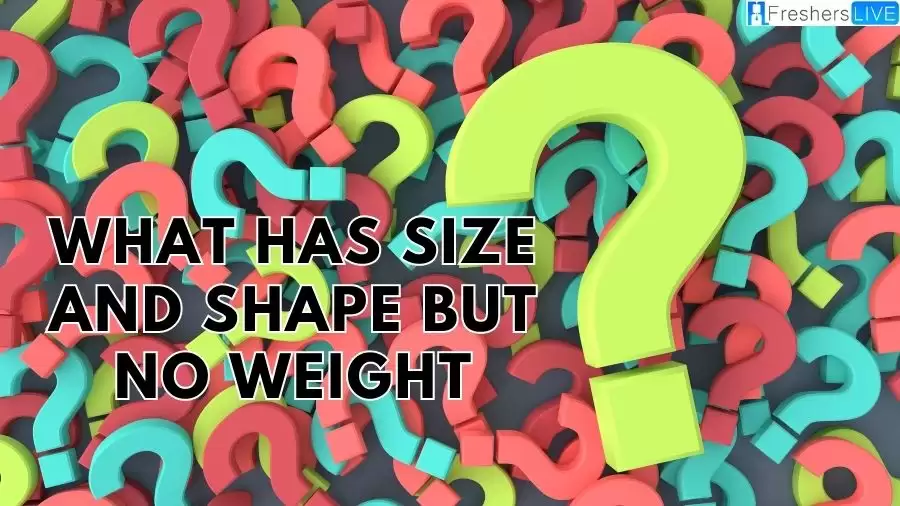What Has Size and Shape But No Weight? Riddle Answer and Logical Reason Explained
by Reshwanth A
Updated Jul 05, 2023

What has Size and Shape but no Weight?
Many people are fans of solving riddles and enjoy logical challenges. It's fascinating how simple-looking riddles can actually carry deep meanings and make us think. Here is a popular riddle that has been circulating on social media and capturing people's attention, putting their minds to the test. So, without any more waiting, here it is:
"What has Size and Shape but no Weight?" Riddle
Take your time to think about the words in this riddle, as they carry some weighty significance. But don't worry, once you find the answer, you'll see that it's actually quite simple.
What has Size and Shape but no Weight? Riddle Answer and logical reason Explained
What has Size and Shape but no Weight? The solution to the riddle is an Everything in zero gravity. In zero gravity, objects and individuals experience a lack of gravitational force, resulting in a unique environment where conventional laws of physics can behave differently. One logical reason for stating that everything is affected in zero gravity is that without the force of gravity, there are no stable reference points or forces to keep objects in place or dictate their behavior.
In the absence of gravity, objects and substances that would typically settle or fall to the ground on Earth would instead float freely in all directions. This phenomenon can be observed on the International Space Station (ISS) or during spacewalks, where astronauts and objects appear to float effortlessly.
What is a Riddle?
Riddles have been a captivating form of intellectual exercise for centuries, engaging the minds of both the young and the old. Their inherent ambiguity and enigmatic nature make them intriguing and enticing, enticing individuals to unravel their hidden meanings. Whether presented as a thought-provoking question, a cleverly crafted statement, or a poetic verse, riddles stimulate our cognitive faculties, inviting us to delve into the depths of our imagination and analytical prowess.
These puzzling conundrums serve multiple purposes, serving as a source of entertainment, a test of wit, and even a means of imparting knowledge. They challenge our ability to think outside the box, encouraging us to explore alternative perspectives and consider unconventional solutions. Riddles often employ wordplay, clever metaphors, or intricate logical deductions, adding layers of complexity to their intricate web of words.
Types to solve a Riddle?
Riddles, with their diverse nature, offer a plethora of intriguing challenges to solve. Here are several examples of different types of riddles and the methods often employed to unravel their mysteries:
Enigmas:
Enigmas are riddles that shroud their meaning in metaphorical or allegorical language. They require the solver to think deeply, employing ingenuity and careful analysis to decipher their hidden message. These riddles often demand an understanding of symbolism and abstract thinking to unlock their true meaning.
Conundra:
Conundra rely on puns, wordplay, or clever trickery to create a puzzle that confounds the mind. They play with the multiple meanings or sounds of words, leading the solver down unexpected paths. To solve these riddles, one must possess a keen sense of linguistic nuances, an ability to think creatively, and a willingness to explore alternative interpretations.
Mathematical or Logical Riddles:
These riddles challenge the solver to employ mathematical or logical reasoning to arrive at the correct answer. They may involve numerical patterns, logical deductions, or complex equations. Solving these riddles demands analytical thinking, problem-solving skills, and a solid understanding of mathematical concepts or logical principles.
Tricky Visual Riddles:
Visual riddles utilize optical illusions, spatial reasoning, or other visual cues to create a puzzle that challenges the mind. They may present seemingly contradictory or perplexing images, requiring the solver to decipher hidden details or perspectives. Solving these riddles often necessitates keen observation, visual analysis, and the ability to think outside conventional boundaries.
Word-based Riddles:
Word-based riddles leverage the properties of language itself to create mind-bending puzzles. They may involve anagrams, homophones, or wordplay to obscure the intended meaning. Decoding these riddles requires linguistic proficiency, a deep understanding of vocabulary, and the ability to recognize linguistic patterns and word associations.
What has Size and Shape but no Weight - FAQs
The solution to the riddle is an Everything in zero gravity.
A riddle is a statement, question, or phrase that has a double or veiled meaning, usually in the form of a puzzle to be solved. Riddles can be presented in various ways, such as questions, statements, or poems. They often require critical thinking and creative problem-solving skills to figure out the answer or solution.
No, riddles are enjoyed by people of all ages. There are riddles specifically designed for children that are simpler and more accessible, helping them develop cognitive skills and expand their vocabulary.
The best approach to solving a riddle is to carefully read or listen to the riddle multiple times, paying close attention to every word and clue.
While there is no foolproof strategy for solving all riddles, there are some general techniques that can be helpful. These include carefully analyzing the wording, looking for hidden clues, considering metaphorical or symbolic interpretations, and using logical reasoning.







